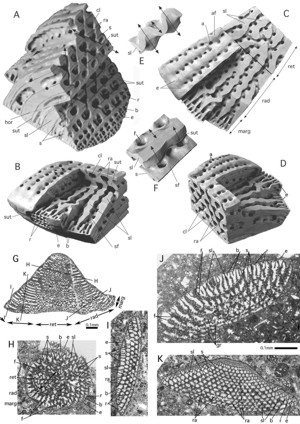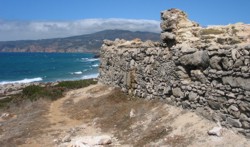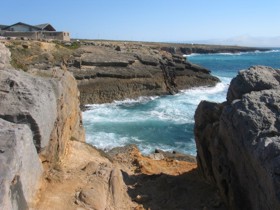From the guidelines, as from January 2013"People do not need to wait for permission to log your EarthCache. Requiring someone to wait is not supported by the EarthCache guidelines. People should send their logging task answers to you, then log your EarthCache. When you review their logging task answers, if there is a problem, you should contact them to resolve it. If there is no problem, then their log simply stands."

Orbitolina belong to the Phylum Foraminifera and these (Palorbotolina lenticularis) can be observed near Praia da Cresmina west of Lisbon. They are associated with Aptian (125 – 112 m.a.; Lower Cretaceous) age micritic or intramicritic bluish-grey limestones (Ramalho et al., 1981).
 These limestones represent a marine transgression that allowed the formation of a platform with barrier. Palorbitulina characterised the farthest internal lower littoral domain.
These limestones represent a marine transgression that allowed the formation of a platform with barrier. Palorbitulina characterised the farthest internal lower littoral domain.
In the Cascais area the distribution of sedimentary rocks and their fossil fauna are indicative of several episodes of sea level fluctuations.
The sea was warm and shallow covering a generally sub horizontal submarine platform. The geological record indicates that the disappearance of brines in the Upper Berriasian (145-140 M.a.) – Lower Valanginian (136 – 140 M.a.) transition causes typical lagoonal fauna to disappear and the start of the implementation of a true open marine system.
During the Aptian (125-112 M.a) the geological record indicates a marked marine transgression (landward migration of the shoreline). Deepening of the sea level allowed the flourish of deep-sea (benthic) organisms such as the Palorbitolinas, brachiopods and other bryozoans.
Foraminifera have a geological range from the earliest Cambrian (542 m.a.) to the present day.
The Foraminifera, ("Hole Bearers") are a large group of amoeboid protists with reticulating pseudopods, fine strands of cytoplasm that branch and merge to form a dynamic net. They typically produce a test (the skeleton or skeletal system is a strong framework that supports the body. External rigid frameworks, such as those found in some invertebrates (e.g. insects), are termed exoskeletons. Internal rigid frameworks, such as those found in most vertebrates (e.g. mammals), are termed endoskeletons. In some cases, skeletons may also be referred to as tests), or shell, which can have either one or multiple chambers, some becoming quite elaborate in structure. About 275,000 species are recognized, both living and fossil. They are usually less than 1 mm in size, but some are much larger, and the largest recorded specimen reached 19 cm.
Foraminifera are found in all marine environments, they may be planktic (shallow sea) or benthic (deep sea) in mode of life. The generally accepted classification of the foraminifera is based on that of Loeblich and Tappan (1964). The Order Foraminiferida (informally foraminifera) belongs to the Kingdom Protista, Subkingdom Protozoa, Phylum Sarcomastigophora, Subphylum Sarcodina, Superclass Rhizopoda, Class Granuloreticulosea. Unpicking this nomenclature tells us that foraminifera are testate (that is possessing a shell), protozoa, (single celled organisms characterised by the absence of tissues and organs), which possess granuloreticulose pseudopodia (these are thread-like extensions of the ectoplasm often including grains or tiny particles of various materials). Bi-directional cytoplasmic flow along these pseudopodia carries granules which may consist of symbiotic  dinoflagellates, digestive vacuoles, mitochondria and vacuoles containing waste products; these processes are still not fully understood. In the planktic foraminifera Globigerinoides sacculifer dinoflagellate symbionts are transported out to the distal parts of rhizopodia in the morning and are returned back into the test at night. The name Foraminiferida is derived from the foramen, the connecting hole through the wall (septa) between each chamber.
dinoflagellates, digestive vacuoles, mitochondria and vacuoles containing waste products; these processes are still not fully understood. In the planktic foraminifera Globigerinoides sacculifer dinoflagellate symbionts are transported out to the distal parts of rhizopodia in the morning and are returned back into the test at night. The name Foraminiferida is derived from the foramen, the connecting hole through the wall (septa) between each chamber.
The importance of foraminifera
Because of their diversity, abundance, and complex morphology, fossil foraminiferal assemblages are useful for biostratigraphy, and can accurately give relative dates to rocks. The oil industry relies heavily on microfossils such as forams to find potential oil deposits.
Calcareous fossil foraminifera are formed from elements found in the ancient seas they lived in. Thus they are very useful in paleoclimatology and paleoceanography. They can be used to reconstruct past climate by examining the stable isotope ratios of oxygen, and the history of the carbon cycle and oceanic productivity by examining the stable isotope ratios of carbon; see d18O and d13C. Geographic patterns seen in the fossil records of planktonic forams are also used to reconstruct ancient ocean currents. Because certain types of foraminifera are found  only in certain environments, they can be used to figure out the kind of environment under which ancient marine sediments were deposited.
only in certain environments, they can be used to figure out the kind of environment under which ancient marine sediments were deposited.
For the same reasons they make useful biostratigraphic markers, living foraminiferal assemblages have been used as bioindicators in coastal environments, including indicators of coral reef health. Because calcium carbonate is susceptible to dissolution in acidic conditions, foraminifera may be particularly affected by changing climate and ocean acidification.
Foraminifera can also be utilised in archaeology in the provenancing of some stone raw material types. Some stone types, such as chert, are commonly found to contain fossilised foraminifera. The types and concentrations of these fossils within a sample of stone can be used to match that sample to a source known to contain the same 'fossil signature'.
The cache
At the coordinates supplied look at the two outcrops as per the image supplied and observe the Orbitolina - these look like "chinese hats" (see image below). Tell me, via e-mail, what their average size is (e.g. 15 cm or 150 mm) and I will get back to you with permission to log the cache.E-mail me the answers through my GC profile to validate your find. Please quote the reference/name of the cache in your answers.

NO tell-tale photos in the logs.
Have fun!
The help by fellow geologist, Prof. Paulo Fonseca (Faculty of Science of the University of Lisbon), is greatly appreciated in the creation of this cache.
Sources: here, here and here and RAMALHO, M.M. et al., 1980. Carta Geológica de Portugal, Notícia Explicativa da Folha 34C - Cascais. Serviços Geológicos de Portugal, 87p.

Orbitolina!......Orbito o quê???
Foraminifera é um filo de protozoários rizópodes, onde se classificam os foraminíferos. São unicelulares, cujo citoplasma emite pseudópodes finos, ramificados e pegajosos. São dotados de uma carapaça, ou teca, cuja constituição pode ser de calcária, quitinosa ou de partículas aglutinadas do meio, que contém uma ou mais câmaras, com uma ou várias aberturas.
 São, na maior parte, marinhos bentônicos, alguns pelágicos. Seus fósseis são utilizados na indústria do petróleo na datação de rochas e reconstrução de paleoambientes (não são indicadores de petróleo). Têm importância econômica, e atualmente são conhecidas cerca de 250.000 espécies, quando consideradas as viventes e as fósseis.
São, na maior parte, marinhos bentônicos, alguns pelágicos. Seus fósseis são utilizados na indústria do petróleo na datação de rochas e reconstrução de paleoambientes (não são indicadores de petróleo). Têm importância econômica, e atualmente são conhecidas cerca de 250.000 espécies, quando consideradas as viventes e as fósseis.
Ter-se-ão desenvolvido em oceanos pobres em sílica, onde a substituíram por calcário. Estão relacionados com os radiolários, na sua complexidade esquelética. Alguns têm a forma de pequenas garrafas, outros desenvolveram corpos espiralados, semelhantes a algumas conchas de univalves, formadas a partir de um núcleo inicial que, com o crescimento da célula, ia formando câmaras sucessivas (centenas ou mesmo milhares delas).
A cache:
As coordenadas levam-te para sul do Forte da Cresmina onde se podem observar fósseis de Palorbitulina lenticularis. Reconhecerás os fósseis pela sua estrutura em disco parecendo-se como "chapéus de chinês".  Para poderes logar esta cache quero que me digas qual o tamanho médio (em cm ou mm se quiserem) destas criaturas.
Para poderes logar esta cache quero que me digas qual o tamanho médio (em cm ou mm se quiserem) destas criaturas.
Enviem-me uma mensagem com as devidas respostas para validar o vosso found. Por favor referenciem o código da cache ou o seu nome quando enviarem as respostas.
Nada de fotos reveladoras nos logs!

Agradece-se a amabilidade do geólogo Prof. Paulo Fonseca da Faculdade de Ciências da Universidade de Lisboa na criação desta earthcache.
Divirtam-se!
 The most exciting way to learn about the Earth and its processes is to get into the outdoors and experience it first-hand. Visiting an Earthcache is a great outdoor activity the whole family can enjoy. An Earthcache is a special place that people can visit to learn about a unique geoscience feature or aspect of our Earth. Earthcaches include a set of educational notes and the details about where to find the location (latitude and longitude). Visitors to Earthcaches can see how our planet has been shaped by geological processes, how we manage the resources and how scientists gather evidence to learn about the Earth. To find out more click HERE.
The most exciting way to learn about the Earth and its processes is to get into the outdoors and experience it first-hand. Visiting an Earthcache is a great outdoor activity the whole family can enjoy. An Earthcache is a special place that people can visit to learn about a unique geoscience feature or aspect of our Earth. Earthcaches include a set of educational notes and the details about where to find the location (latitude and longitude). Visitors to Earthcaches can see how our planet has been shaped by geological processes, how we manage the resources and how scientists gather evidence to learn about the Earth. To find out more click HERE.
